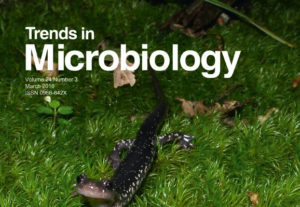
Cow Knob salamander, Plethodon punctatus, from George Washington National Forest, VA
Cover photo: Doug Woodhams.
In a section on Science and Society, Woodhams and colleagues describe state-of-the-art approaches for amphibian disease management. These include probiotic bacteria that persist from aquatic tadpole to terrestrial adult frog stages, and bacteria that produce volatile compounds including hydrogen cyanide that can kill fungus from a distance and could be applied to soils. These management tools were announced on the heels of a moratorium on salamander trade to help prevent invasion by a new salamander chytrid. This is the 50th peer-reviewed publication from new assistant professor Doug Woodhams, and was supported by the UMass Boston Endowed Faculty Career Development Award.
Woodhams DC, Bletz M, Kueneman J, McKenzie V. (2016) Managing Amphibian Disease with Skin Microbiota. Trends in Microbiology, 24:161-164.